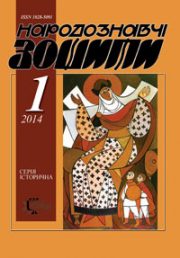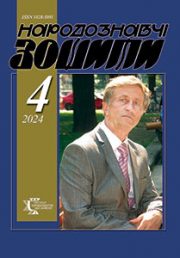The Ethnology Notebooks. 2024. № 2 (176), 359—368
UDK [398.3:634.7:641:615.89](477.86-11-2)”18/20″
DOI https://doi.org/10.15407/nz2024.02.359
TSURKAN Mariana
- ORCID ID: https://orcid.org/0009-0009-4267-5157
- Candidate of Historical Sciences (Ph.D. in History),
- Junior Researcher at the Ethnology Institute
- of the National Academy of Sciences of Ukraine,
- 15, Svobody Avenue, 79000, Lviv, Ukraine,
- Contacts: e-mail: mariannatsyrkan@gmail.com
Abstract. The purpose of the article is to highlight the process of harvesting berries, wild fruits, and tree juice and find out their use in nutrition and folk medicine by residents of Horodenka district, Ivano-Frankivsk region. In the article the place of various berries, wild fruits and tree juice in the structure of harvesting is clarified. The names for berries (such as «rosy», «black raspberry», «wild», «forest», and «berries») and wild fruits (such as «hawthorn», «turf», «sverbilus», «robin», «aphonia», and «terninky») in the local language are distinguished. Terms for picking berries, fruits from wild bushes and trees, and juice from trees are defined. Traditions associated with the consumption of the first berry were mentioned. Different containers and devices for picking berries, wild plants, and tree juice are marked. The question of harvesting berries, wild fruits, and tree juice for nutrition and folk medicine was not a subject of professional ethnographic research, that is why it constitutes the scientific novelty and relevance of the article.
The object of the research is the harvesting berries, wild plants, and tree juice as well as geographical and climate phenomena, along with socio-historical processes that have impacted the development and formation of harvesting in Pokuttya. The author’s field ethnographic research materials in the villages of Horodenka district, Ivano-Frankivsk region in 2016 as well as the scientific research of the XIX—XXI centuries are the source base of this article. The chronological framework of the article covers the late — early XXI centuries.
The methodological basis is formed on principles of theoretical and historical analysis as well as descriptive and analytical systematization methods, along with observations made by the author. Collection of field ethnographic material was carried out using the interview method according to the author’s questionnaire.
Keywords: Pokuttya, ethnography, additional activities, gathering, berries, wild fruits, juice from trees, nutrition, folk medicine.
Received 23.02.2024
REFERENCES
- Kolberg, O. (1882). Рокусiе. Ethnographic image (Vol. 1). Krakow: Printing House of Jagiellonian University [in Polish].
- Mrochko, Fr.K. (1897). Sniatynshchyna. Scientific and literary guide (Vol. XXV, part. III, pp. 193—207) [in Polish].
- Wajgel, L. (1877). Essay of the city of Kolomyya. Kolomyya [in Polish].
- Pjotrovych, S. (1907). Witch doctor and fortune Evdokiya Boichuk. Lud. Lwow [in Polish].
- Ilkevych, G.(Ed.). (1841). The fairy tales and riddles of Galiciya region. Viden’ [in Ukrainian].
- Sapeliak, O. (2017). Pokutian’ nutrition. Ethnology notebooks, 1 (133), 136—153 [in Ukrainian].
- Bazhansky, M. (1982). The beauty of the Sniatyn Region: rivers, streams, forests, meadows, gardens, cities, villages and the material and spiritual culture of their inhabitants: Encyclopedia. Detroit [in Ukrainian].
- Kobzey, I. (1985). Zariche. Almanac of Stanislavsky land. A collection of materials for history of Stanislavov and Stanislav region (Vol. 2, pp. 589—593). New York; Sidney; Parish; Toronto [in Ukrainian].
- Vasylchuk-Kobylyanska, M. (2008). The kitchen of Grate Kluichiv. Kolomyya and Kolomyyshchyna. A collection of memorials and articles about recent past (Vol. 2, pp. 85—87). Filadelphiya [in Ukrainian].
- Fedankiv, V. (1975). Solotvyna in 1926—1939 years. Almanac of Stanislavsky land. A collection of materials for history of Stanislavov and Stanislav region (Pp. 750—753). New York; Sidney; Parish; Toronto [in Ukrainian].
- Babij, V., & Mulyarchyky, M. i V. (2001). Serafyntsi (Yanhoriv). Ethnographic papers, memoirs, everything. Ivano-Frankivsk [in Ukrainian].
- Levkun, Ya. (2003). Villager of stork and golden wheat. Snyatyn [in Ukrainian].
- Kylymnyk, S. (1957). The Ukrainian year in folk customs in historical lighting (Vol. IV: Summer cycle). Vinnipeg; Toronto [in Ukrainian].
- Levkun, Ya. (2009). The tablets of Horodenka region of Pokyttya. Horodenka [in Ukrainian].





